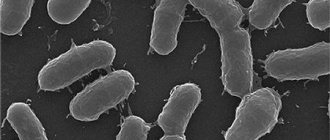Cheilitis is an isolated inflammatory process in the area of the mucous membrane, skin and red border of the lips. Outwardly it looks like swelling with redness and peeling of tissue. It can be an independent disease or a symptomatic manifestation of other pathologies. Sooner or later, almost every person encounters it, but at a young age the disease is noticeably milder, recurs less often and has no complications. In older people, due to a weakened immune system, periodic relapses of cheilitis can cause malignant tissue degeneration.
Causes of cheilitis
Cheilitis is a polymorphic and multifactorial disease that can be triggered by infections, physical and chemical environmental factors, as well as internal characteristics of the body. Among them:
- constant exposure to the open air - inflammation and peeling of the lips occurs when chapped by hot or cold air, excessive insolation;
- the presence of chronic diseases with skin manifestations of symptoms - various types of dermatitis, psoriasis, lupus erythematosus, lichen planus, syphilis, etc.;
- allergic reactions of the body - mainly with food allergies;
- tissue irritation from regular exposure to chemicals, including medications (for example, nasal drops);
- various neurological disorders, severe stressful situations, depression, constant anxiety;
- endocrine abnormalities - primarily hyperfunction of the thyroid gland, diabetes mellitus.
Diagnostics
Diagnosis of diseases and pathological conditions accompanied by swelling of the lips is carried out by a dentist. According to indications, patients are referred for consultation to an allergist or oncologist. Objective examination methods are of key importance. The diagnostic program includes the following procedures:
- Survey
. The doctor finds out the time and circumstances of the onset of the symptom, determines other manifestations, and examines the dynamics of the course of the disease. - Physical examination
. The specialist evaluates the localization, severity, and extent of swelling, detects other changes (discoloration, cracks, crusts, ulcers), examines the mucous membranes and skin of other areas, and conducts a dental examination. - Lab tests
. If an endogenous cause of edema is suspected, a biochemical blood test is prescribed. To determine the type and level of differentiation of neoplasms and distinguish cheilitis from other pathologies, a biopsy is performed followed by histological examination. - Allergy tests.
Indicated for allergic reactions, prescribed to clarify the allergen. Skin tests, provocative tests, and other studies are performed. Allergy testing is carried out in a specialized office.
Allergy tests
Types of cheilitis
Manifestations of cheilitis may vary depending on the type and cause of the disease. There are:
- Exfoliative cheilitis - manifested by peeling of the red border of the lips, with rare areas of burning and dryness of the lips themselves.
- Exudative cheilitis - symptoms of the disease are supplemented by swelling and severe pain. The skin in inflamed areas may become covered with baked crusts, which greatly complicate the patient’s life.
- The glandular form affects the minor salivary glands. Their congenital or acquired proliferation is observed, followed by infection with bacteria. In this case, the source of infection can be caries, periodontitis or banal plaque. Outwardly it manifests itself as the formation of cracks on the surface of the lips, which begin to become wet over time.
- The allergic form occurs under the influence of household, cosmetic or food irritants (often this is lipstick). There are characteristic manifestations of allergic cheilitis in musicians who play wind instruments and in those who like to chew pencils. This type of inflammation is characterized by severe swelling, often with the formation of blisters, as well as itching, severe redness and burning.
- Meteorological cheilitis develops under the influence of weather conditions (wind, sun) and is manifested by burning, itching with small weeping blisters, in place of which erosions and ulcers form over time.
- The atopic form manifests itself as a symptom of dermatitis or neurodermatitis. Manifests itself in the form of redness and ulcers in the corners of the lips.
- The hypovitaminosis type of the disease is formed in response to a severe lack of vitamins, mainly vitamins A, C, B2. A characteristic burning sensation affects the surface of the lips, mouth and tongue. The mucous tissues take on a swollen appearance, cracks on the lips peel and bleed.
- Macrocheilitis is a response to damage to adjacent nerves (facial nerve neuritis), while itching and swelling from the tongue can spread to other parts of the face.
Attention! With a long course, there is a high probability of inflammation degenerating into a malignant neoplasm. This is especially typical for the meteorological form, which, in the absence of proper treatment, is often complicated by precancerous diseases.
What to do if your lips are chapped
The main causes of dry lip skin Beautiful and moisturized lips emphasize the health of the skin, while chapped lips bring a long-term feeling of discomfort and do not look aesthetically pleasing. Lips are the most sensitive part of the face. Their structure consists of many nerve endings. The absence of sebaceous and sweat glands makes the thin skin of the lips truly fragile and delicate. In summer, lips become chapped less often. In hot sunny weather, daily comprehensive facial skin care is more than enough. But in the autumn-winter period of the year, lips are especially susceptible to dryness and peeling. This is due to the fact that the thin skin of the lips is devoid of a hydrolipid film, which acts as a protective barrier from external irritants. These include: sudden temperature changes, cold wind, humid air, heating. Drinking hot drinks outside exposes your lips to the cold air. In addition to external factors, there are a number of internal causes of dryness and flaking. Let's look at the most common of them. Lack of vitamins A and E, dehydration. To compensate for the lack of vitamins during the cold season, balance your usual diet with foods high in fiber. Pay attention to vitamin complexes. Discuss your choice with your doctor first. Insufficient consumption of clean water provokes dryness and peeling not only of the skin of the lips, but gradually leads to dehydration of the entire body. Install an application on your mobile phone that will remind you to drink water on time and normalize your water balance.
Bad habits. Biting and licking aggravate the condition of chapped lips. Every time you feel discomfort on your lips, moisturize them with a nourishing product.
Improper care provokes the appearance of cracks on chapped lips and aggravates the problem. Dryness often appears after frequent use of cleansers. Therefore, carefully study the label of facial cleansing cosmetics. Daily hygienic lip skin care is definitely one of the most common beauty procedures. It begins with morning cleansing of dead skin particles and continues throughout the day. The sensitive skin of chapped lips requires delicate care. High-quality cosmetics will help quickly restore lips from chapping, provide reliable protection, long-term nutrition and hydration.
We replace dryness and flaking with tenderness and hydration . Are you familiar with the concept of biosynergy? This is a combination of innovative and natural ingredients that enhance each other's effects. It is on this combination that the CERAMED moisturizing lip balm was developed. The key components of the balm are ceramides. They are responsible for smoothness and hydration of the skin, restore cells and smooth the skin of the lips. Young skin actively produces ceramides at a natural level, but with age their quantity decreases. Lack of lipids causes dry skin of the lips and provokes irritation. When applying a balm with ceramides to damaged lips, the intercellular process of regeneration of the upper layer of the epidermis is launched - the skin is renewed. Lipids are able to restore defects in the intercellular structure caused not only by external factors, but also by skin diseases (atopic dermatitis, psoriasis). Like bricks, ceramides are embedded in the deep layers of the skin, forming a reliable protective barrier that promotes the rapid healing of wounds and cracks on the thin skin of the lips. The complex of ceramides included in the balm retains moisture on the surface of the skin and restores chapped lips.
Properties of lip balm with ceramides.
- Relieves the feeling of dryness and discomfort
- Restores chapped, chapped lips
- Helps moisturize and restore skin
- Prepares lips for makeup
The thick texture of the balm instantly moisturizes and nourishes the skin, eliminating the feeling of dryness. For greater effect, the balm can be used as a night mask. Applying a thick layer of nourishing cera balm to the skin of your lips will ensure your lips look well-groomed and healthy in the morning. CERAMED balm does not contain fragrances or dyes, so the risk of an allergic reaction is minimized. With daily use of the balm, lips acquire natural color, softness and elasticity. The quality and effectiveness of Cera-Balm has been confirmed by clinical studies at the CosmoProdTest Medical Scientific and Practical Center for Expert Evaluation of Nutrition and Cosmetics.
Cera-advice When choosing decorative cosmetics for lips, it is worth considering the content of moisturizing emollients in the composition. The most active are essential oils and a complex of vitamins A and E. We recommend not to overuse matte lipstick - it dries out the skin of the lips. Before applying matte or liquid lipstick, moisturize your lips with a thin layer of Cera Balm. A delicate scrub or superficial peeling will do an excellent job of cleansing the skin of dead skin particles. Products that use natural oils or honey in their recipes additionally saturate the skin with amino acids and fats. After each cleansing procedure, apply a thick layer of Cera Balm to your lips. Ceramed lip balm will revive chapped lips and give them deep care and reliable protection until the first summer sun!
Diagnosis of cheilitis
There are no specific laboratory tests to detect cheilitis.
All diagnosis of the disease is carried out by visual examination. To determine the causes of inflammation, diagnostics of the gastrointestinal tract may be prescribed for the presence of Crohn's disease or ulcerative colitis. Additionally, allergy tests are performed to exclude food allergies. General laboratory tests allow you to check the condition of the body and determine the possible causes of cheilitis:
- low levels of vitamins due to hypovitaminosis can provoke exfoliative cheilitis;
- bacterial cultures of smears and biopsies are performed in patients with immune system disorders in the absence of results from the treatment;
- testing for markers of HIV infection, herpes, the presence of fungal or bacterial microflora, respectively, allows us to identify the viral, bacterial or fungal causative agent of cheilitis;
- a blood test for anemia, ESR are required to assess general health;
- examination of the function of the thyroid and pancreas for endocrine pathologies.
On a note! Cheilitis tends to be chronic with periodic relapses. Self-healing without medical supervision is almost impossible, so try to pay attention to such a “minor” problem and consult a specialist. Diagnosis of the disease is carried out by a general practitioner or attending dentist. In some cases, consultation with an allergist, infectious diseases specialist, dermatovenerologist or gastroenterologist may be required.
Allergic cheilitis
A disease that develops in allergy sufferers upon contact with an allergen and affects the surface of the lips. Typical manifestations of this type of cheilitis are a feeling of itching and burning on the lips, dryness and significant discomfort. The lips begin to dry and peel, and the scales of dead epithelium begin to flake off.
The main cause of this disease is the patient’s increased sensitivity to external irritants, in particular to allergens. Allergic, or, as it is also called, contact cheilitis can develop gradually.
It all depends on the patient’s personal sensitivity to allergens, and it can develop over several weeks, months and even years. The duration of this process is determined by the peculiarities of the endocrine system, as well as the degree of manifestation of allergic reactions.
This disease practically does not appear in children. According to statistics, most patients with allergic cheilitis are women over twenty years of age.
Causes of the disease
In most cases, allergic cheilitis is caused by contact allergic irritants. Among the most common allergens that cause cheilitis is lipstick. It is not the lipstick itself that is dangerous, but the substances it contains - rhodamine, eosin and others. Provoking factors also include low-quality dental implants and plastic dentures.
Allergic manifestations may appear after contact with citrus fruits, as well as in patients who have the habit of chewing pencils or pens. The disease is also common for those whose work involves playing wind instruments or hazardous chemical production.
Symptoms of the disease
The disease manifests itself as hyperemia and swelling of the lips, as well as a sensation of itching and burning, accompanied by the formation of erythema. Small painful blisters appear and burst on the affected areas of the lips. If the pathogenic process is prolonged, over time, small scars and scars will form in their place on the lips. Dry lips only increase over time.
Inflammation almost never extends beyond the red border around the lips. In rare cases, it may spread to adjacent skin. Sometimes the inflammatory process moves to the oral mucosa. This form of allergic cheilitis is characterized by hyperemia (significant redness of the tissues), the appearance of noticeable swelling of the tissues, and when trying to palpate, pain occurs.
Diagnosis and treatment
Diagnosis of the disease is carried out by a dentist together with an allergist. To determine the allergen, it is necessary to conduct allergy tests.
When making a diagnosis, it is important to distinguish allergic and atopic cheilitis, as well as exclude exfoliative and actinic cheilitis. Treatment of this disease includes the mandatory elimination of the irritant or allergen that caused it.
Systemic (general) and topical (local) drug therapy is used. General therapy refers to the use of medications taken orally. To relieve allergy symptoms, a course of antihistamines is used. If the case is sufficiently complex, the use of corticosteroids may be indicated. In addition, calcium supplements may be prescribed.
Local treatment of allergic cheilitis includes the use of a variety of emollient oils, ointments and balms based on sea buckthorn, vitamin E and others. To avoid the recurrence of the pathology, it is necessary to take an allergy test in order to eliminate any contact with the allergen in the future. It is also advisable to reconsider your diet and carefully consider the choice of cosmetics.
Treatment of cheilitis
Different forms of cheilitis differ in their approach to treatment. Collectively, the impact may include:
- correction of the psycho-emotional sphere - a neurologist prescribes sedatives, tranquilizers, a psychologist or psychotherapist conducts appropriate psychotherapy;
- physiotherapy - treatment with laser, ultrasound, magnetotherapy, electrophoresis is prescribed locally; they relieve irritation and accelerate tissue regeneration;
- drug symptomatic therapy - non-hormonal anti-inflammatory drugs are prescribed; in case of severe inflammation - hormonal drugs;
- immunotherapy – strengthen the immune system by taking immunomodulators and immunostimulants;
- vitamin therapy - taking vitamins A, C, group B (mainly vitamin B2) is of great importance;
- surgical treatment – typical for glandular cheilitis with enlargement of the salivary glands; Both laser ablation with a surgical laser and direct removal of areas of the gland are used;
- antiallergic therapy with antihistamines.
Additionally, the doctor may prescribe diet therapy with the exclusion of foods that provoke allergies or chemical irritation of tissues (spicy foods, saltiness and marinades). When staying outdoors for a long time, it is imperative to use special protective equipment.
Treatment
Conservative therapy
Patients are advised to avoid eating too hot and too cold food, staying in cold and high humidity conditions, and applying decorative cosmetics. They use medicinal and non-medicinal methods. Treatment tactics are determined by the cause of lip swelling:
- Mechanical damage
. For bruises and hematomas, apply cold; for burns and abrasions, apply ointments with an anti-inflammatory and wound-healing effect. - Allergy
. Antihistamines are used. In severe cases, general glucocorticosteroids are indicated. - Cheilitis
. Depending on the type of disease, sedatives or anti-inflammatory drugs, protective creams, hormonal ointments, and vitamin preparations are prescribed. - Herpes
. Antiviral ointments are applied to the affected area 5-6 times a day. - Erysipelas
. Antibiotics from the group of macrolides or penicillins are recommended, treatment of the affected area with antiseptics, and subsequent application of ointments.
Among the physiotherapeutic methods for some pathologies, UVB, ultrasound, and laser therapy can be used. For diseases that occur due to decreased immunity, immunocorrectors, general tonics, and multivitamin preparations are prescribed.
Surgery
Surgical interventions for lip swelling are rarely required. Taking into account the pathology, the following operations are performed:
- Mechanical damage
: primary surgical treatment of maxillofacial wounds, plastic surgery after burns. - Dental diseases
: opening of a subperiosteal or submucosal abscess, tooth extraction during periostitis, removal of salivary gland stones. - Tumors
: lip resection.
In the postoperative period, antibiotics, analgesics are prescribed, and dressings are performed.
Prevention of cheilitis
The main prevention of cheilitis is maintaining a healthy lifestyle and timely treatment of any infectious and allergic diseases. Basic list of measures:
- Eat right - a balanced menu should contain an abundance of fruits, vegetables, herbs, nuts, fish, and high-quality dairy products.
- Reduce the use of cosmetics - try to choose hypoallergenic formulations and constantly monitor the skin's reaction.
- Dose your exposure to open wind or direct sunlight.
- Protect your lip skin from physical and chemical damage.
- Take vitamin and mineral complexes periodically in courses (after consultation with your doctor).
- Give up bad habits.
- Seek medical advice promptly if you have characteristic symptoms.
Remember: your health is the greatest value, and constant monitoring of its condition is very important to maintain the body’s performance, especially in old age.
What should healthy lips look like?
Those who know how to moisturize their lips can boast of their naturally beautiful appearance. The natural red hue is due to the location of blood vessels near the surface.
Signs of healthy lips:
- smooth skin;
- smooth texture;
- pleasant natural shade;
- no peeling or cracking.
Healthy lips have even, uniform pigmentation without light or dark areas. Healthy skin looks elastic, it is not prone to irritation, peeling and allergies.
If a whitened area is detected, it means that the delicate skin does not receive enough hydration or there are not enough vitamins in the body:
- A,
- E,
- WITH.
First you need to learn how to use the right cosmetics. This applies to all people, because even if there are no problems with the lips, a careful attitude will not be superfluous.
You need to be able to choose the right cosmetics. And the first thing people pay attention to is the composition. Oil-based products should contain only natural ingredients:
- jojoba oil,
- cocoa,
- shi,
- nut oils.
It is best to buy products at a pharmacy or labeled “pharmacy product”. This means that cosmetics:
- passed dermatological tests,
- approved by experts
- considered safe.
In addition to moisturizers, there are small life hacks to improve the color and contour of your lips.
Shock freezing is often used: using ice to massage the lips. With prolonged exposure to cold, the appearance of the lips deteriorates, but short periods of exposure to shock cold cause the capillaries to expand sharply. Blood flows closer to the skin and provides:
- more active saturation with oxygen and nutrients,
- more saturated lip color.
The most common advice for lip care is the use of special lipstick. But there are several ways to moisturize your lips without chapstick.











